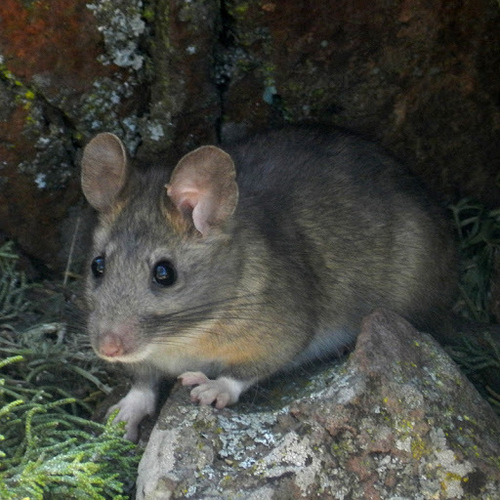
Bushy-tailed Woodrat
Neotoma cinerea, or the bushy-tailed woodrat, is a nocturnal collector, building intricate nests with gathered treasures. Its lush tail and curious nature make it an endearing part of North America’s rocky landscapes, playing a vital role in seed dispersal and habitat structuring.
5 years
Lifespan
269.0 - 397.0 g
Weight
Length: 25 - 47 cm
Size
Brown, Grey, Black
Color
60 days
Age of Sexual Maturity
14-42 days
Age of Weaning
8 mph
Top Speed
Least Concern
Conservation Status
Stable
Population Trend
Characteristics
The bushy-tailed woodrat, known scientifically as Neotoma cinerea, inhabits rocky outcrops and arid forests of North America. Notable for its long, bushy tail and large, rounded ears, this nocturnal rodent is famous for its 'packrat' behavior, collecting objects to build elaborate nests called middens.
Distribution Range of the Bushy-tailed Woodrat
Neotoma cinerea, commonly known as the bushy-tailed woodrat, is native to North America. Its geographical distribution spans western Canada and the western United States, including regions such as the Rocky Mountains, the Great Basin, and parts of the Pacific Northwest. Specifically, it is found in British Columbia, Alberta, Saskatchewan, and extending south through the U.S. states of Washington, Oregon, Idaho, Montana, Wyoming, Colorado, Utah, Nevada, California, and New Mexico.
Bushy-tailed Woodrat's Habitat
Environmental Conditions
The bushy-tailed woodrat typically inhabits rocky outcrops, cliffs, and talus slopes within forests, shrublands, and mountainous regions. The species prefers environments with abundant rock cover and crevices for nesting and protection. It is adaptable to a range of altitudes, from lowland forests to alpine zones, and is commonly found at elevations between 1,500 to 3,000 meters.
Ecological Niche
Neotoma cinerea is a nocturnal herbivore that plays a significant role in its ecosystem by dispersing seeds and aiding in nutrient cycling. It feeds on a variety of plant materials, including leaves, stems, seeds, and fruits. The species is known for its behavior of collecting and storing plant material and other objects in its nests, which are typically located in rocky crevices or under logs. These nests, called middens, can provide important ecological insights into past vegetation and climate conditions.
Copyright @ Nature Style Limited. All Rights Reserved.
 English
English